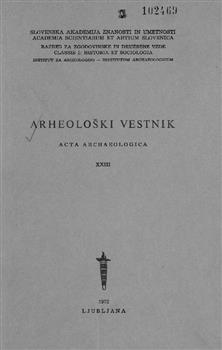Figurai applique from Hvar
Abstract
The above discussed brazen applique was discoverd on the island Hvar near the vilage Vrbanj between Stari Grad and Jelsa in 1968 and is now in private property. On a fully cast applique with a slightly concave back side a part of a peg with which it was fixed on the basis is preserved (perforations in a leafy frame are recent). That the applique is a serial product is indicated by various imperfections in the construction, which are the result of the damage on the mould. The size of the applique is 57 mm X 60 mm (Fig. 1), the patina on it is artificial. The applique is iconographically determinated by the leafy frame (corona), composed of leaves and fruits of ivy (Hedera helix), a typical characteristic of god Dionysus in the antique art. The antique art formed two visual models of the deity, which were imitated in the later periods. These are the types of the bearded Dionysus, originating from the first cult images in a form of a column, and the type of the beardless, youthful Dionysus which is, according to E. Curtius, a result of "rejuvenation” of the Greek gods in the first half of the 5th century B. C. This two visual models appeared during the Antiquity parallelly, nevertheless the representations of the yourthful Dionysus are after 4th century B. C. more frequent. The discussed applique forms a fully cast en face representation of Dionysus. Formally it is composed of the face and the leafy frame — corona, which has here a double function: firstly it is a leafy frame which intensifies the feeling of plasticity, and secondly it is the gerland — corona. In comparison with the antique representations of the heads embellished with garlands, there are no analogies between those and our aplique. On en face representations as well as on representations in profile, the garland is only partially shown and never forms full circle. En face representations in the antique decorative art are without exceptions comprehended as a segment of full plastic. Even in the most frequent en face representations, representations of Gorgona and Medusa, that function as a symbol, we find full circle of snakes round the face rarely, and even then such representations are twodimensional. The use of brass as a material, and the realization of the garland — corona round the face in a manner, unusual in the antique art, almost excludes the origin of our applique in the Greek and more or less in the Roman epoque.
Downloads
Downloads
Published
How to Cite
Issue
Section
License

This work is licensed under a Creative Commons Attribution-NonCommercial-ShareAlike 4.0 International License.
Authors guarantee that the work is their own original creation and does not infringe any statutory or common-law copyright or any proprietary right of any third party. In case of claims by third parties, authors commit their self to defend the interests of the publisher, and shall cover any potential costs.
More in: Submission chapter





